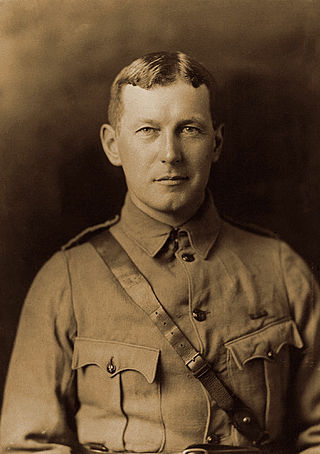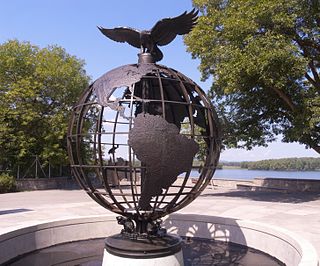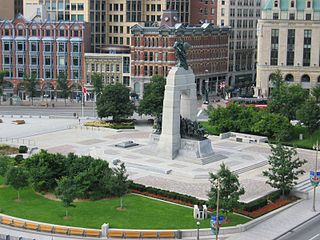
Parliament Hill, colloquially known as The Hill, is an area of Crown land on the southern banks of the Ottawa River in downtown Ottawa, Ontario, Canada. Its Gothic revival suite of buildings, and their architectural elements of national symbolic importance, is the home of the Parliament of Canada. Parliament Hill attracts approximately three million visitors each year. Law enforcement on Parliament Hill and in the parliamentary precinct is the responsibility of the Parliamentary Protective Service (PPS).

Lieutenant-Colonel John McCrae was a Canadian poet, physician, author, artist and soldier during World War I, and a surgeon during the Second Battle of Ypres, in Belgium. He is best known for writing the famous war memorial poem "In Flanders Fields". McCrae died of pneumonia near the end of the war. His famous poem is a threnody, a genre of lament.

7 Rideau Gate is the Canadian government's official state guest house for very important dignitaries, such as visiting heads of government or other high-level officials. The house is located in Ottawa, Ontario, near other official residences such as Rideau Hall and 24 Sussex Drive.
Bytown is the former name of Ottawa, Ontario, Canada. It was founded on September 26, 1826, incorporated as a town on January 1, 1850, and superseded by the incorporation of the City of Ottawa on January 1, 1855. The founding was marked by a sod turning, and a letter from Governor General Dalhousie which authorized Lieutenant Colonel John By to divide up the town into lots. Bytown came about as a result of the construction of the Rideau Canal and grew largely due to the Ottawa River timber trade. Bytown's first mayor was John Scott, elected in 1847.

Sussex Drive, also known as Ottawa Regional Road 93, is an arterial road in Ottawa, Ontario, the capital of Canada. It is one of the city's main ceremonial and institutional routes. Travelling roughly parallel to the Ottawa River, Sussex Drive begins as a continuation of Sir George-Étienne Cartier Parkway at Rideau Gate, at the entrance to Rideau Hall. It travels south to Rideau Street, with the portion south of St. Patrick Street forming the northbound half of a one-way pair with Mackenzie Avenue. Both Mackenzie Avenue and Sussex Drive connect with Colonel By Drive at their southern end, which continues south alongside the Rideau Canal.

Lieutenant-Colonel John By was an English military engineer. He is best known for having supervised the construction of the Rideau Canal and for having founded Bytown in the process. It developed and was designated as the Canadian capital, Ottawa.

The Drill Hall at Cartier Square is a dedicated military training facility in Ottawa, Ontario, Canada. It has been a local landmark since its construction in 1879. The drill hall is 70 meters (230 ft) long and has two 43 meters (141 ft) tall mansard towers.

The current Ottawa City Hall is the city hall of Ottawa, Ontario, Canada. The downtown complex consists of two connected buildings: a modern wing located on Laurier Avenue and a 19th-century heritage wing located on Elgin Street. Although City Hall has frontage on two major streets, the main entrance is on Laurier Avenue, and the municipal address is 110 Laurier Avenue West.

The Transportation Building, 10 Rideau Street, Ottawa, Ontario, Canada is a historic Gothic revival/Chicago school office tower. The building stands at the intersection of Sussex Drive and Rideau Street.

The John G. Diefenbaker Building is a building in the New Edinburgh neighbourhood of Ottawa, Ontario. The building served as Ottawa's city hall from August 2, 1958, to January 1, 2001, and afterward was commonly known as Old City Hall. Purchased in 2003 by the Government of Canada, it was known by its municipal address, 111 Sussex Drive, until September 2011 when it was renamed after Canada's 13th prime minister, John Diefenbaker. The building is located on Green Island where the Rideau River empties into the Ottawa River.

The Ottawa Memorial is a monument in Ottawa, Ontario, that "commemorates by name almost 800 men and women who lost their lives while serving or training with the Air Forces of the Commonwealth in Canada, the West Indies and the United States and who have no known grave. " Located on Sussex Drive overlooking the Ottawa River near the Rideau Falls, the monument was unveiled in 1959 by Elizabeth II, Queen of Canada. It is maintained by the Commonwealth War Graves Commission. During the Second World War, 798 men and women killed with Commonwealth air forces in or over Canadian territory.

Confederation Park(French: Parc de la Confédération) is a public park and National Historic Site of Canada, located in the downtown core of Ottawa, Ontario, Canada. It is bordered on the south by Laurier Avenue and Ottawa City Hall; on the east by the Rideau Canal and National Defence Headquarters; on the north by the Mackenzie King Bridge, the Rideau Centre and the National Arts Centre; and to the west by Elgin Street and the Lord Elgin Hotel.

St. John the Evangelist Anglican Church is an Anglican church in downtown Ottawa, Ontario, Canada, at the corner of Elgin and Somerset streets.

George Harold Baker was a lawyer, political figure, and soldier from Quebec, Canada. He represented Brome in the House of Commons of Canada from 1911 to 1916 as a Conservative Member of Parliament.
The Plaza Bridge in Ottawa, Ontario, Canada, is an automotive and pedestrian bridge that crosses the Rideau Canal just south of the Ottawa locks. It joins Wellington Street and Elgin Street in the Downtown core to the west with Rideau Street to the east. The Chateau Laurier abuts the bridge at the east end, while Parliament Hill is just beyond the west end. It is the northernmost bridge over the canal, just north of the Mackenzie King Bridge.

Confederation Square is an urban square in Ottawa, Ontario, Canada, and is considered the second most important ceremonial centre in Canada's capital city, after Parliament Hill. Roughly triangular in area, with Canada's National War Memorial at its centre and the Valiants Memorial at its periphery, the square is bounded by Wellington Street to the north and branches of Elgin Street to the east and west.
This is a timeline of the history of Ottawa.

Beechwood Cemetery, located in the former city of Vanier in Ottawa, Ontario, is the National Cemetery of Canada. It is the final resting place for over 82,000 Canadians from all walks of life, such as important politicians like Governor General Ramon Hnatyshyn and Prime Minister Sir Robert Borden, Canadian Forces Veterans, War Dead, members of the Royal Canadian Mounted Police, and men and women who have made a mark on Canadian history. In addition to being Canada's National Cemetery, it is also the National Military Cemetery of Canada and the Royal Canadian Mounted Police National Memorial Cemetery. A woodland cemetery founded in 1873, it is 64.7 hectares and is the largest cemetery in the city of Ottawa.

The Capital Pathway, also known informally as the Bike Path, is a 220-kilometre (140 mi) recreational pathway interlinking many parks, waterways and sites in Ottawa, Ontario and Gatineau, Quebec. Most of the pathway is paved, and allows an almost continuous route through the National Capital Region.

Alexis Hannum Helmer was killed in battle during the Great War while serving with the 2nd Battery, 1st Brigade, Canadian Field Artillery. He is known as being part of the inspiration for In Flanders Fields through his friendship with John McCrae.




















